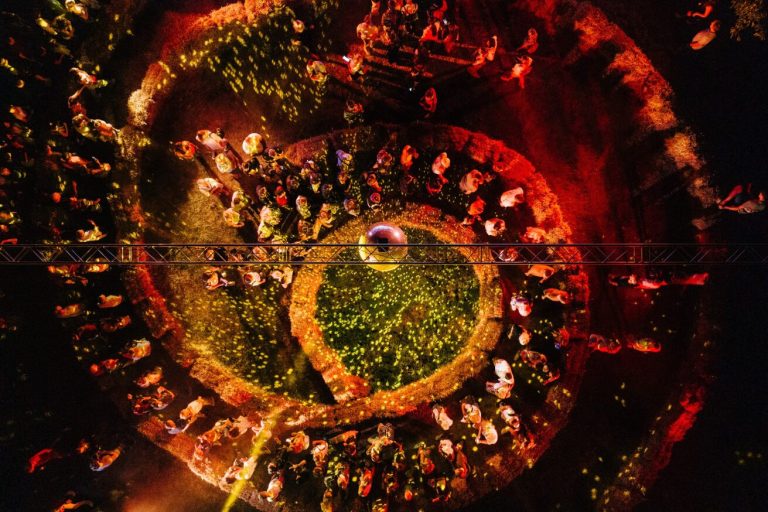(In)tangible national landmarks have been created for
centuries. The diversity of European nations has, through the ages, been
expressed through the uniqueness of each costume, and within it are woven, both
literally and figuratively, threads from different corners of the world. The
title of the European Capital of Culture is a perfect opportunity to get a
bigger picture of national landmarks of Vojvodina and Serbia through the
European lens. In light of this, we will bring the tradition of the region – folk
heritage, Serbian dance kolo,
traditional costume, and culture and arts societies in Novi Sad, closer to the
audience.
We also invite you to visit the ‘Following the Thread’
exhibition, which will, with the aim to stress the importance of diverse folk
heritage and preservation of folk costumes, be open in the ‘Mladost’
Institution for Culture and Education in Futog on 10 February.
The Traditional Serbian Kolo
– From a Lead Dancer to an ‘Ace’
In 2017, the traditional dance with a strong symbol, the
Serbian kolo, was added to UNESCO’s
List of Intangible Cultural Heritage, while its value has been nurtured by
culture and arts societies from Novi Sad and the whole of Serbia for decades.
The kolo dance is
part of the story about what we are and the values we are known for in the
world. Instead of kolo, the terms
‘oro’ or ‘horo’, from the Greek word ‘horos’ (group of people, the circle
dance) can be used. A little is known about how old the kolo is and since it has been performed, it is assumed that the kolo was danced in the 18th century. It
is characteristic for the South Slavic nations. The early Slavs believed that
energetic body movements and turning would contribute to the Sun rotating
happily. While performing kolo, the
energy, both group and individual, has been encouraged, and the so-called
magical action is taken, since closing the circle is a symbol for protecting
the community from everything that may be harmful. Everyone dancing kolo is equal, except the lead dancer.
He is either the best player, or he is entitled to the position of the first
dance according to a custom. The last one in the kolo is called the ‘ace’. If a boy joined kolo next to a girl, making her leave the chain, it would be a
great shame and offense for a boy.
It was easier to dance on flatlands than on a wavy,
mountainous ground. This is why in Vojvodina, people performed light, small
steps, without separating their legs a lot from the ground, with variety of
steps and improvisations. Experienced dancers could even dance with a glass filled
with water on their heads, of course, without spilling it. The musical
accompaniment is dominated by orchestral, mostly tamburitza playing.
Vojvodina is inhabited by different ethnic communities.
Natives and immigrants (Croatia, Bosnia and Herzegovina, Montenegro),
Hungarians, Romanians, Bunjevci, Šokci, Croats, Czechs, Slovaks, Roma,
Ruthenians, Croats, Macedonians, Bulgarians, etc. The dance repertoire of Serb
immigrants in the 20th century is completely different. They also
perform a silent dance (đikac, bukovac and glamoč kolo) and dances
with vocal and instrumental accompaniment. Ethnic diversity of Vojvodina
encouraged the preservation of traditional music and dances of each community.
The famous Vojvodina silent kolos
performed in closed-circle are: (Banat, Bačka, Syrmia) performed along with a
bagpiper, Paorsko kolo, Gajdaško kolo, Bunjevačko kolo, Staračko
kolo, etc. From the middle of the 20th century, under the
influence of city dances, kolo began
to open, forming a semicircle, the most famous of which kolos are: Majstorsko kolo,
Trgovačko kolo, Pančevačko kolo, Vidino kolo,
etc. In Vojvodina, couple dances are represented and the most famous are: Cigančica, Mađarac, Keleruj, etc.
Kolo was often transformed into prose – Bora Stanković’s
‘Koštana’ and ‘Impure Blood’, Stevan Sremac’s ‘Zona Zamfirova’, Branko
Radičević’s ‘The Parting of Schoolfriends’, etc. Its value has been nurtured by
culture and arts societies from Novi Sad, Serbia and the region. The most
famous culture and arts societies in Novi Sad include Sonja Marinković
Association for Culture and Arts (KUD), Svetozar Marković Culture and Arts
Society (KUD), Petőfi Sándor Culture and Arts Society (KUD), Ruthenian Culture
and Arts Society (KUD), Slovak Culture and Arts Society (KUD), Pavel Jozef
Šafárik Culture and Arts Society (KUD). Today, culture and arts societies are
the so-called mobile museums, which preserve the Serbian intangible heritage
from oblivion.

Symbolism Woven Into Folk Costumes
Folk costume is a symbol of ethnic identity, and in the
past, it was everyday clothing. It was the way of dressing that showed where
people came from and to which national community they belonged. Since different
peoples have mixed in this region for centuries, the folk costumes have been
woven with threads from different parts of the world. They represent the
so-called document-mosaic about the history of migrations on European soil. The
old Serbian folk costumes in Vojvodina contain traces of different times and
influences of other peoples who lived with Serbs in mixed ethnic settlements.
The main parts of women’s folk costumes are petticoats and
shirts, which were worn under an overgown, the lower skirt (suknjerac), over which the upper skirt
was worn (made of domestic fabrics, while during festive occasions, it was made
of store-bought raw fabric). The skirts were long to the ankles. The folk apron
was worn over the skirt. It was made of the same fabric and decorated the same
as yelek, which was worn over the shirt. The yelek was a hip-length waistcoat,
made of dark-coloured corduroy or silk cloth, decorated with gold lace or gold
embroidery. It was fastened with clothing fasteners or laced with a cord at the
front. White aprons and skirts were worn during summer days. During winter,
women wore kozhukh (or ćurak), a fur
coat or a big wool scarf. Women’s footwear consisted of white socks, colorful
slippers, knitted pockets or wool socks, leather and wool shoes (opanci) for work and clogs (cokule) for
winter. Young women and girls braided their hair into two braids and let them
down their backs or wrapped them around their heads or in a bun at the back of
their heads. After getting married, women wore džega on their heads, until they had their first child or until a
new bride came into the house. The simplest form of džega was a small
triangular scarf which later became a special hat that was covering the bun and
part of the hair, while the lower part hung down the neck. Džegas were adorned
with golden embroidery. Girls wore a few strings of ducats – seferini, as a jewel and a sign of
wealth.
Men in Vojvodina wore characteristic loose pants and a
shirt, made of white cloth. The shirt was decorated with white and gold
embroidery, worn over the pants, i.e. underwear, how they called it back then.
The formet, an embroidered piece of
clothing that could be worn on any shirt, was especially popular. It could be
seen under waistcoat and coat. The waistcoat was made of black fabrics,
corduroy, velvet or silk brocade. The most common ornaments used as decoration
on waistcoats had different motifs – plants, horseshoes, initials and years.
The number and type of ornaments on the waistcoat depended on the wealth and
social status of a boy wearing it.
During spring and autumn, boys wore broadcloth coats – doroc (coat) or kabanica (raincoat). In the second half of the 19th
century, thigh-length coats, called bekeš,
bena or jankel came into use. During winter, male costumes were
complemented by thick cloth shirts and black-cloth trousers (čakšire) combined with a coat. Patent
leather boots or leather shoes (opanci)
and slippers for the poor were worn during summer days. During winter, boots or
leather shoes with obojci
(rectangular pieces of woven woollen cloth wrapped around the feet) were worn,
and they were later replaced by natural wool-coloured or red socks. In Bačka,
during winter, wooden shoes – clogs were worn, and to keep them warm, they put
hay and straw inside. In the second half of the 19th century, shoes
were also worn. In winter, they wore fur hats (šubara) on their heads. Gentlemen could not be seen on the street
without black felt hats. All gentlemen except, of course, Laza Kostic. Jewellery
was an obligatory part of men’s folk costume. Men’s jewellery is called toke
and was worn on yelek or some other upper part of clothing. It consists of
several silver or bronze plates or strings of puli, sometimes gilded.
The main raw materials for making clothes were plant fibres
of hemp, flax and cotton. Wool, lamb and sheep fur were used for winter
clothing. These are all raw materials that Vojvodina plain abundantly provided.
Gradually, during the second half of the 19th century, costumes
became equated with civic fashion. This is how folk costumes remained an
indicator of culture and customs in the past.
Author: Historian Ljiljana Dragosavljević Savin, MSc.
Photo: Srđan Doroški







